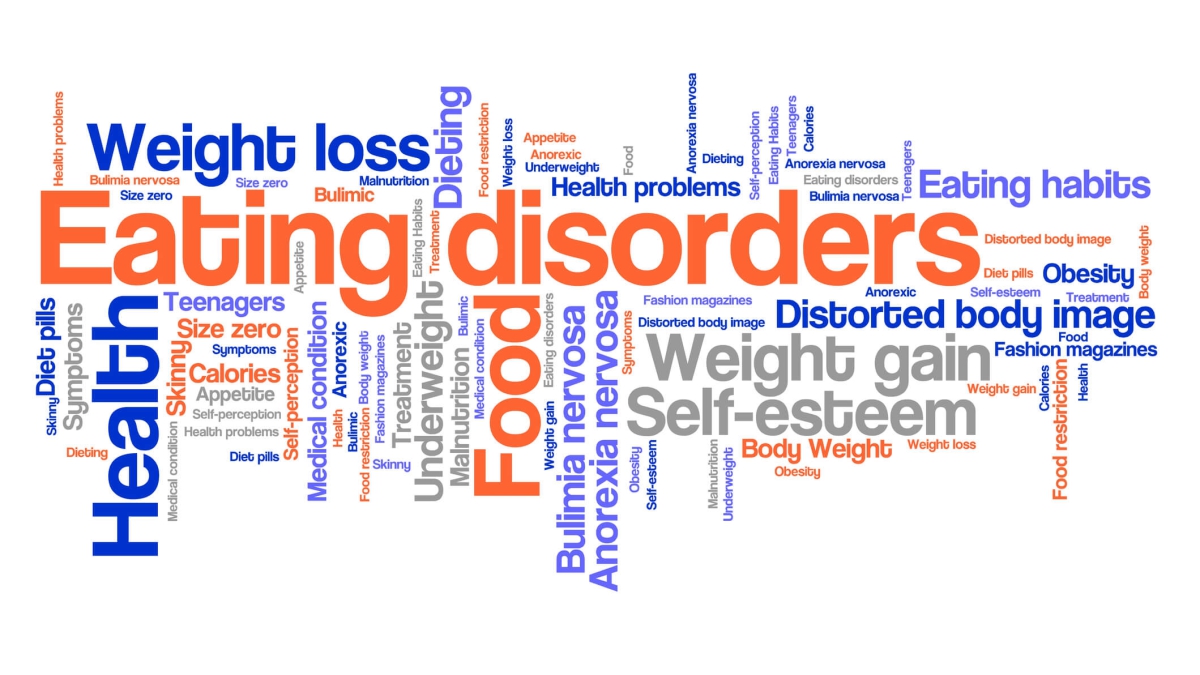Understanding Eating Disorders

Throughout the COVID-19 pandemic, one topic has come up over and over again: weight gain. The COVID-19 (pounds) and how to lose them appear to be on most people’s minds. The topic of weight loss is not just becoming more common in conversation: it is also becoming increasingly common in the offices of doctors and mental health professionals.
According to the National Eating Disorders Association, “eating disorders have the second highest mortality rate of all mental health disorders, surpassed only by opium addiction.” With eating disorders on the rise, it is important to lift away the veil of misconceptions surrounding them and shine a light on the facts, as well as understand their symptoms, causes, and treatments.
Who comes to mind when you hear the words “eating disorders”? Chances are you imagined a skinny, young, white woman. Eating disorders are often associated with skinny white affluent girls (SWAGs). However, this stereotype is false. A study by Zhen Hadassah Cheng et al. in the journal Eating Behaviors looked at 1,177 young women and found that “eating disorders affect ethnic minorities as much as Whites...” If an individual does not align with the SWAG image, their chance of being recognized as needing eating disorder treatment severely declines. A study by K. R. Sonneville and S. K. Lipson in the International Journal of Eating Disorders found that men are significantly less likely than women to be diagnosed with or treated for eating disorders, and non-affluent students are less likely to receive, or even be perceived as needing, eating disorder treatment than their affluent peers. Another study by Kathryn H. Gordon et al. in the same journal found that when participants read stories depicting eating disorders, the eating disorders are more likely to be recognized when the characters are white women than when they are Hispanic or African-American women, even when symptoms are identical.
Part of dismantling the SWAG stereotype is understanding what eating disorders are. The DSM-5, the guide health professions use to diagnose mental disorders, lists six main feeding and eating disorders: anorexia nervosa, bulimia nervosa, binge eating disorder, avoidant/restrictive food intake disorder, pica, and rumination disorder. If an individual's eating pattern does not fit any of these six disorders, they may be diagnosed with “other specified feeding or eating disorder.”
Anorexia nervosa, often just called anorexia, is one of the eating disorders most often portrayed in the media. It is characterized by a distorted perception of one's weight and fear of gaining weight, often resulting in a low body weight. However, it is important to remember that what constitutes “a low body weight” is different for everyone and may not align with what is expected based on SWAG body types. Anorexia warning signs can include, but are not limited to, preoccupation with weight and calories, feeling “fat” despite weight loss, an overly rigid exercise schedule, and constantly wanting to “burn off” calories.
Bulimia nervosa (also referred to simply as bulimia) is another eating disorder often seen on TV and in movies. Bulimia is a cycle of binging and then restricting calories. Calories can be reduced through methods such as purging, fasting, or excessive exercise. Individuals with bulimia may be uncomfortable eating around others and hoard food.
However, not all eating disorders revolve around weight loss. Binge eating disorder centers around regularly eating excessive amounts of food in a short amount of time, feeling unable to stop, and feeling guilty afterwards. Symptoms of binge eating can include being at normal/above normal weight, eating when not hungry and until one feels uncomfortably full, eating alone or in hiding, feeling like one's eating is not controllable, and feeling depressed over one's eating habits.
Avoidant restrictive food intake disorder (ARFID) is a lesser-known eating disorder. Individuals with ARFID will limit food not to maintain a specific weight or body type but due to challenges such as difficulty digesting certain foods, sensitivity to specific tastes and textures, or fear of negative consequences of eating, such as choking. ARFID symptoms include weight loss, nutritional deficiency, and avoiding specific food groups due to the way they look/feel/taste.
Pica and rumination disorder are additional lesser-known eating disorders. Individuals affected by pica eat things that are not considered food, like chalk or hair, for example, while individuals affected by rumination disorder regurgitate their food before it can be digested and then may swallow it again or spit it out.
Though eating disorders are extremely detrimental, damaging the cardiovascular, gastrointestinal, neurological, and endocrine systems, recovery is possible. Eating disorders primarily affect adolescents, and the sooner treatment begins, the better. Treatment can include psychological therapy, nutrition counseling, medication, or a combination of all three. There are also residential programs that provide treatment, as well as online helplines. An important first step is talking to a medical professional who will help connect the patient to a treatment team and develop a long-term recovery plan.
While the exact causes of eating disorders are unknown, researchers do know that there are a variety of risk factors, including genetics, psychology, and social environmental conditions. A case study by Bárbara C. Machado et al. in the European Eating Disorders Review provides a prime example of social environmental forces being a risk factor for eating disorders. The study focused on women in Portugal and found that individuals with anorexia reported more “parental comments about eating...[and teasing] by peers about shape, weight, eating and appearance” than women without psychiatric conditions.
Diet culture is another significant factor when it comes to perpetuating eating disorders. Diet culture equates thinness with healthiness and moral value. For example, a list titled “guilt-free desserts” would be something that promotes diet culture, as it encourages the idea that eating dessert is something that people should feel guilty about. Calling a dessert “guilt free” may seem like no big deal, but it does matter. A study by Rachel F. Rodgers et al. in the International Journal of Eating Disorders specifically cites “exposure to thin ideal‐ and diet culture‐related content” as a contributor to eating disorders. The emphasis on the moral value of thinness does not just contribute to eating disorders but also to weight discrimination. A study by R. M. Puhl et al. in the International Journal of Obesity found that “[w]eight/height discrimination is prevalent in American society and is relatively close to reported rates of racial discrimination, particularly among women.”
Equating health and weight is also an issue. A study by Linda Bacon and Lucy Aphramor in Nutrition Journal found that when people focus on health promotion and healthy behaviors and do not use weight as the measurement of their progress, they are more effective at improving physiological measures of health, such as blood pressure. And the benefits don’t end there. Focusing on health promotion (vs. weight) is also more effective at improving health behaviors (such as eating habits) and psychosocial outcomes (like body image and self-esteem).
There are also things that we can do in our own homes to limit diet culture. First, prioritize health, not weight. Second, embrace the idea of moving to feel good. Exercise can be used as a tool to feel our best, rather than lose weight. Third, avoid phrases like “I deserve that donut since I went for a run today.” Food is not something that needs to be deserved. Lastly, unfollow social media accounts that make you feel bad about your body and instead follow accounts that show diverse and realistic bodies, or delve into resources like the “Health at Every Size” movement that provide science-based approaches to health.
Whether dismantling diet culture or learning about the symptoms, causes, and solutions to eating disorders, we can all take a step towards a world where all bodies are seen as good and more than just a scale comes to mind when we think about our health.
Taskeen Khan has a bachelor's degree in integrative biology and a minor in sustainability, energy, and the environment from the University of Illinois at Urbana-Champaign. She is passionate about science education and communication, as well as research.
Reprinted from the Fall 2021 issue of Halal Consumer© magazine with permission from the Islamic Food and Nutrition Council of America (IFANCA®) and Halal Consumer© magazine.

















